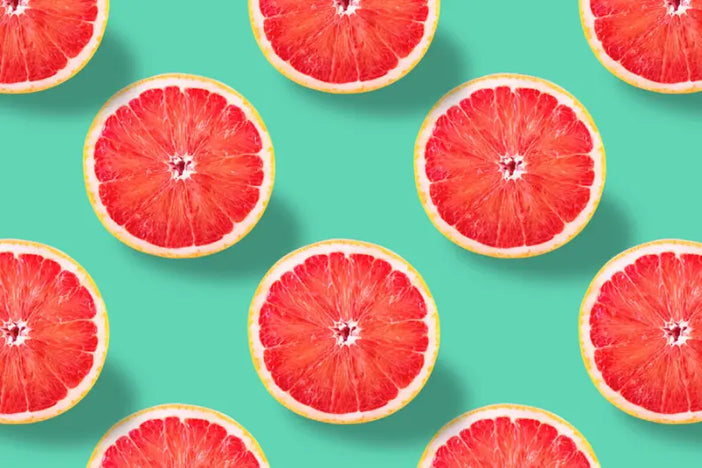Diabetes & Fruits - What Should You Eat And When?

Taking a bite into a fresh, crisp apple, or some other tasty fruit is a great way to meet your sweet tooth cravings. That way you are also ingesting a variety of healthy nutrients.
But for people with diabetes, the sugar content found in fruit can serve as a cause for concern. Luckily, fruits can and should be a part of your diabetes diet. You need to know what you can eat and when, and how to eat it.
Eating more fruits is linked to a lower risk of developing type 2 diabetes. Two recent studies showed.

Can type 2 diabetics eat fruit and how does fruit affect blood sugar?
If you are living with type 1 and type 2 diabetes fruit can have a place in your diet. The key is to consume it in moderation. It is important to make sure you are not metabolizing too many grams of carbs through fruit consumption. So always consider what you eat. Eating fruit can be part of your daily menu if you:
Keep track of carbohydrate consumption.
Use a plate technique
Consider the glycemic index of a fruit.
Keeping track of carbohydrates consumption
Adjust carbohydrate consumption depending on your medications and activity levels. Keep track of the carbs in all your meals, snacks, and beverages during the day. Consult with a dietitian or a healthcare provider to determine the appropriate carbohydrate intake for you.
If your meal plan needs to change make sure to adjust it. Usual calorie consumption should be about half of the total daily calorie intake. That means that if a person consumes about 1800 calories per day 900 calories should come from carbohydrates. At 4 calories per gram, that’s 200–225 grams of carbs a day. Want to learn more about carbs and diabetes? Read this blog post.
Fruits are a great source of fiber and healthy carbohydrates; some of them are:
- Bananas - 26,95 grams of carbs;
- Apples - 25,13 g of carbs;
- Mango - 24,72 g of carbs.
Using a plate technique
Step one: Arrange non starchy vegetables on half of the plate.
Cauliflower, broccoli, spinach, kale, beets, Brussels sprouts, summer squashes like zucchini, cucumbers, and tomatoes are examples of non starchy vegetables.
They are high in vitamins, minerals, fiber, and phytochemicals. Since they are low in calories and carbs, people diagnosed with diabetes can eat more of them.
Step two: Fill a quarter of a plate with carbohydrates.
Grain, starchy vegetables, fruits, milk, and yogurt are all carbohydrate sources. Whole grains such as brown rice and quinoa should be preferred by people having diabetes.
Carbohydrates are the primary source of energy for your body. They contribute to the proper functioning of the brain, liver, heart muscles and central nervous system.
Step three: Fill a quarter of a plate with lean proteins.
Lean meat, fish, dairy, soy products, legumes, and nuts are all good sources of lean protein. Legumes may be used as a protein or a carbohydrate on a plate.
Although high-carb plant-based proteins contain more carbohydrates than animal proteins, they also contain a lot of fiber, which is good for blood glucose control.
For cooking and salad dressings, use plant-based oils like olive or canola oil. For salad preparation, use healthy fats like almonds, peas or avocado. Make your meal complete by adding a glass of water or some other zero calorie beverage.

Which fruits should be avoided for people with diabetes?
If you live with diabetes, there really are no forbidden fruits as long as you follow few recommendations. The GI is a useful tool for making dietary decisions. Take into consideration that fruits and fruit products with high GI scores can raise your blood sugar levels. So even though they are not forbidden they should be consumed in moderation, those are:
- Watermelons GI: 72;
- Pumpkin GI: 75;
- Pineapple GI: 66;
- Fruit juice GI: 40-68;
- Dried fruit GI: 64;
- Applesauce GI: 40-65;
- Canned fruits with added sugar.
The benefits of fruits for diabetics
Diabetes is a chronic but manageable metabolic disorder. Your pancreas either is not making enough insulin or the insulin that is produced isn’t working as effectively as it should. Insulin is the hormone regulating the movement of sugar to the cells and helps your body metabolize sugar.
The body struggles to control levels of blood sugar, and, carbohydrates directly influence blood sugar levels. People with diabetes must constantly be conscious of their carbohydrate intake. Fruit may be substituted for other carbohydrate sources in your meal plan, such as starches, grains or dairy. While still ensuring they consume the nutrients they need to survive and thrive.
Aside from its carbohydrate count, fruits provide diabetics with several nutritional and other benefits:
-
A great source of fiber:
-
A healthier option for a sweet treat:
-
Contain other essential nutrients:
-
Rich in water content:
What is the best fruit for a diabetic to eat?
The best fruit for a diabetic to eat is the fruit with a low GI or different Glycemic Index. The GI is a measurement of how much particular food raises blood sugar. Fruit contains fructose, a natural sugar. So eating it as a snack or dessert will satisfy your sweet tooth, while still providing beneficial nutrients. Fruits contain vitamins, phytochemicals, and other nutrients that are beneficial for your health. Here is a list of fruits that would have a great impact on your health and wellness:
- Tomatoes GI: 15;
- Avocados GI: 15;
- Blackberries GI: 25;
- Oranges GI: 40;
- Strawberries GI: 41.
The glycemic index - How to choose fruits?
The glycemic index (GI) is a rating of foods from 1-100. The higher the number, the quicker the food will raise your blood sugar. The nutrient composition, ripeness, cooking method, and amount of processing a food has undergone are all factors that influence the glycemic index. As such, diabetics should choose fruits with a smaller GI rating. Fruits low on the glycemic index are rated under 55 GI.
Low GI fruits:
- Avocados GI: 15;
- Sour cherries GI: 22;
- Plums GI: 24;
- Grapefruit GI: 25;
- Pears GI: 30;
- Apples GI: 36;
- Orange GI: 40;
- Nectarines GI: 40;
- Strawberries GI: 41;
- Peaches GI: 42;
- Bananas GI: 52;
- Blueberries GI: 53;
Eating fruit with a smaller GI score should be preferred over medium and high GI fruits. Though those are also safe for diabetics when consumed in moderation.
Medium GI :
- Kiwi GI: 58;
- Bananas: 58;
- Grapes GI: 59;
- Mango GI: 60;
- Figs GI: 61;
- Pineapple GI: 66.
The medium GI is a rating of foods that are between 56 and 69. You can eat fruit with a medium GI score, but keep in mind to make portions small.
Combining medium GI fruit with lean protein and healthy oils can lower the glycemic load of the portion. The glycemic load of a food is a metric that considers the amount of carbohydrate in a serving as well as how easily it increases blood glucose levels.

Are bananas safe for diabetics?
Bananas are delicious fruits packed with potassium, vitamin B6, vitamin C, and many other important nutrients. Because of its high content of sugars, bananas are often excluded from diabetes patients' diets. Even though they are often excluded, the recommended serving size for diabetes patients is half of a medium banana.
Bananas and their influence on diabetes were studied during 1992. The results showed that ripeness matters more than anything. So be sure to eat your bananas as soon as they are ripe or even a bit greener, because at that point they consist of about 80-90% from starch. Over time that starch turns into sugar.
What about processed fruit products?
People with diabetes should approach eating processed foods carefully or avoid them completely. The body absorbs processed fruits more rapidly, that is resulting in higher blood sugar levels. Processing fruits often removes or reduces levels of certain key nutrients, including vitamins and fiber.
The National Institute of Diabetic and Digestive and Kidney Diseases (NIDDK) recommends that people with diabetes should avoid fruit juice, dried fruit, or canned fruits with added sugar.
Diabetes & fruits – what you should know about fruit for a diabetes diet?
It is recommended that all people eat five servings of whole fruit and vegetables each day. This recommendation is applicable for people with diabetes as well. Although it is always best to take an individual approach and consult with your health care provider on personalized advice.
High GI diets have been related to an increased risk of type 2 diabetes in some studies. According to one survey around 200,000 participants, those who had high GI diets had a 33 percent higher chance of developing type 2 diabetes.
According to a systematic analysis of 24 studies, the probability of developing type 2 diabetes increased by 8% for every 5 GI.
Diets with consumption of low GI fruits showed a lot of benefits.
In women with gestational diabetes, a low-GI diet can help them have a healthier pregnancy.
Low GI diets can help you lose weight and have better control of cholesterol levels. Some studies showed a strong correlation between lower than 55 GI diets and reduction of heart diseases.

What are healthy ways to eat fruits while having diabetes?
Here are some practical tips to help you navigate eating fruits as a diabetic:
- At a mealtime, get the non-starchy vegetables to fill most of your plate. That way you can enjoy fruits for dessert and snack time. Combining non-starchy vegetables and fruits can lower the risk of blood sugar spikes after a meal.
- Include healthy fat at each meal. That way you will encourage a feeling of fullness from the non-starchy (i.e. less filling) vegetables. Healthy fats are promoting antioxidant and nutrient absorption.
- Prefer fresh, whole fruit over fruit juice, dried fruits, and canned fruit. They are usually filled with added sugars and other unnecessary ingredients.
- Keep in mind that a single serving of fruit (15 g of carbs) is roughly the size of a baseball (one cup of fresh fruit or half a cup of processed fruit).
- Distribute your fruit during the day. Instead of two breakfast servings, have one portion for breakfast and one for lunch or as a snack.
If you live with diabetes, there really are no forbidden fruits. Just remember that lower-GI/GL fruits are a better fit for you and should probably be part of your everyday diet.
Of course, everyone’s daily needs vary slightly. Talk to your doctor or registered dietitian/nutritionist about how to create a custom meal plan that works best for your health.
Every day, people around the world connect in our active community to share advice, get support, and help each other live healthier fuller lives, despite their chronic conditions. It is a movement changing lives across the globe. Click here if you would like to have our daily support.




